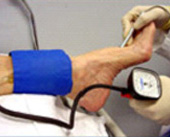- What does this diagnostic test involve?
- Which vessels are usually examined by Doppler ultrasonography?
What does this diagnostic test involve?
Continuous-wave (CW) Doppler ultrasonography enables blood flow to be monitored in the vessel (artery or vein) examined. This is particularly useful in impalpable arteries.
This investigation relies on the Doppler principle, i.e. that the frequency of sound reflected by a moving object (in this case the red blood cells) is changed in proportion to the velocity of the moving object. In the small computer of the device, information is processed and the reflected waves are transformed into audible sound waves. During the test, you may hear a rythmical whooshing sound which represents the blood flow in the vessel examined.
Some portable devices offer the possibility of recording waveforms on paper.
Which vessels are usually examined by Doppler ultrasonography?
With a portable or a hand-held Doppler device it is generally possible to assess:
 relatively superficial arteries of both upper and lower limbs, so that the type of arterial flow is checked based on the form of the wave (either as audible sound or as recorded on paper), which can be monophasic (poor), biphasic (moderate) or triphasic (normal). We can also calculate the ankle-brachial pressure index (ABPI), i.e. measurement of the systolic arterial pressure both in a lower limb at ankle level and in the arm and comparison with each other
relatively superficial arteries of both upper and lower limbs, so that the type of arterial flow is checked based on the form of the wave (either as audible sound or as recorded on paper), which can be monophasic (poor), biphasic (moderate) or triphasic (normal). We can also calculate the ankle-brachial pressure index (ABPI), i.e. measurement of the systolic arterial pressure both in a lower limb at ankle level and in the arm and comparison with each other- superficial veins, usually in a lower limb with varicose veins, for possible reflux of the blood flow in them (with the patient in standing or semi-standing position)
- grafts implanted in relatively superficial sites
Last modified 22/02/2014






